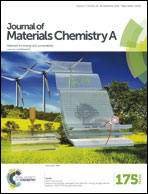Enhancing the thermoelectric performance of nanosized CoSb3via short-range percolation of electrically conductive WTe2 inclusions
Abstract
Compositing is proven to be effective in enhancing thermoelectric performance. The present paper illustrates the thermoelectric study of CoSb3–yWTe2 meso-composites between 300 K and 575 K, where y denotes the weight percentage of WTe2 (y = 0, 3, 6, 9 and 12). Micro-sized WTe2 grains were randomly embedded in the nano-sized unfilled CoSb3 host matrix. We found that the electrical conductivity of CoSb3–yWTe2 composites was markedly increased in a systematic trend with increasing WTe2 content. The enhancement of the electrical conductivity has been attributed to the locally percolated highly conductive WTe2 pellets along with better electrical connections between grains as a result of increased packing density. Meanwhile, the pronounced bipolar peak of pristine CoSb3 was quickly suppressed upon the addition of WTe2. The n-type thermopower of CoSb3–yWTe2 composites became nearly linear between 300 K and 575 K, and the magnitude of thermopower decreased with increasing WTe2 content. The power factor is markedly enhanced up to 59 times that of the pristine CoSb3 upon compositing. The dimensionless thermoelectric figure-of-merit zT value of 0.78 is attained at 575 K, which promises practical applications for the unfilled CoSb3 composites.


 Please wait while we load your content...
Please wait while we load your content...